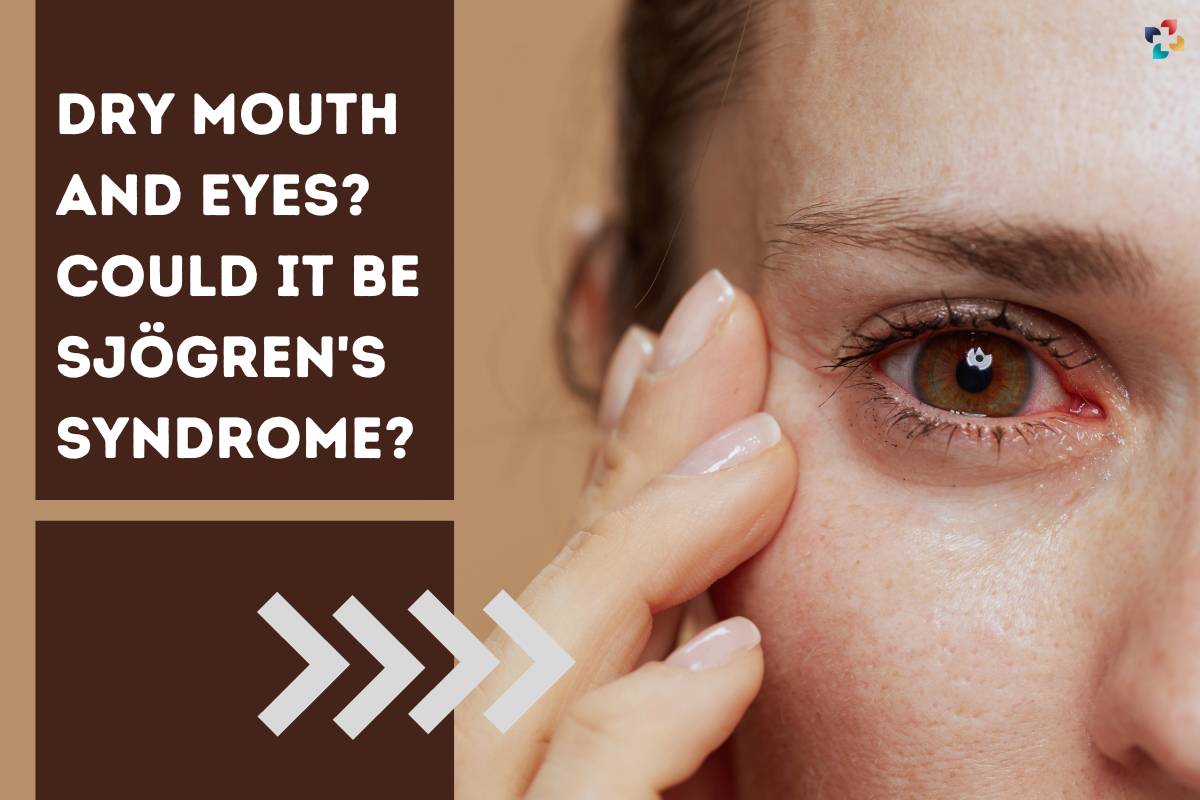Are you commonly facing the issue of dry mouth and eyes? There are chances that you might have Sjögren’s Syndrome. This is an autoimmune disorder, and is relatively uncommon among individuals. This is a syndrome that affects your body’s ability to produce moisture. This mainly leads to dry mouth and eyes, among many other symptoms.
This article delves into the various facets of Sjögren’s Syndrome, including its causes, symptoms, diagnosis, and management, to raise awareness about this often underdiagnosed condition.
Understanding Sjögren’s Syndrome
Sjögren’s Syndrome is a chronic autoimmune disorder characterized by dryness in the eyes and mouth, although it can affect other parts of the body as well. The condition primarily targets the body’s moisture-producing glands, leading to symptoms such as dry mouth and eyes, and dry skin. While it might seem like a minor inconvenience, Sjögren’s Syndrome can have a significant impact on a person’s quality of life. It often goes undiagnosed or misdiagnosed, making awareness and education crucial.
1. Causes and Prevalence
The exact cause of Sjögren’s Syndrome remains unknown, but it is thought to involve a combination of genetic and environmental factors. It typically affects people over the age of 40 and is more common in women than in men. While Sjögren’s Syndrome is relatively rare, it is essential to recognize its symptoms and seek medical attention promptly to improve the quality of life for those affected.
2. Symptoms and Diagnosis

The hallmark symptoms of Sjögren’s Syndrome are dry mouth and eyes. These symptoms can range from mild to severe, significantly affecting a person’s daily life. Other symptoms may include fatigue, joint pain, and even organ involvement in some cases. Diagnosing Sjögren’s Syndrome can be challenging because its symptoms can overlap with other conditions. It often requires a combination of blood tests, imaging, and other diagnostic tools to confirm the presence of the syndrome.
3. Living with Sjögren’s Syndrome
Living with Sjögren’s Syndrome can be challenging, but there are ways to manage the condition effectively. Treatment focuses on relieving symptoms, as there is currently no cure for the syndrome. Artificial tears, saliva substitutes, and medications may help manage dry eyes and mouth. It’s also essential to address any systemic manifestations of the syndrome, such as joint pain or fatigue, through appropriate medical interventions.
4. The Nature of Sjögren’s Syndrome
Sjögren’s Syndrome is considered an autoimmune disorder because it involves the immune system mistakenly attacking the body’s moisture-producing glands. These glands, called exocrine glands, are responsible for producing saliva, tears, and other fluids essential for various bodily functions. When they become the target of the immune system’s attack, their ability to function properly is compromised.
While Sjögren’s Syndrome is most renowned for its hallmark symptoms—dry mouth and eyes—it can affect other parts of the body as well. This is known as systemic involvement and can lead to symptoms such as fatigue, joint pain, and skin rashes. Organ involvement, although less common, is also possible, affecting organs like the lungs, kidneys, and liver.
The Impact of Dry Mouth And Eyes
Dry mouth and eyes are the hallmark symptoms of Sjögren’s Syndrome and can profoundly affect an individual’s daily life. Dry eyes can lead to discomfort, blurred vision, and sensitivity to light, while dry mouth can result in difficulty speaking, swallowing, and even an increased risk of dental issues. Other common symptoms of the syndrome include a persistent dry cough, difficulty in swallowing, and dry skin.
These symptoms are often subtle in the early stages of the condition, making diagnosis challenging. They may also be attributed to other medical problems, leading to misdiagnosis or delayed diagnosis. As a result, it’s crucial to be aware of the potential signs of Sjögren’s Syndrome and consult a healthcare professional if you suspect you may be experiencing them.
Diagnosing Sjögren’s Syndrome
Diagnosing Sjögren’s Syndrome is a complex process due to its diverse and overlapping symptoms. It often involves a combination of clinical evaluation, blood tests, and imaging studies. Here’s an overview of the diagnostic process:

- Medical History and Physical Examination: The first step in diagnosing Sjögren’s Syndrome is a comprehensive review of the patient’s medical history and a physical examination. During this evaluation, healthcare providers may inquire about the presence and duration of dryness symptoms and any associated discomfort.
- Blood Tests: A series of blood tests is typically conducted to assess specific markers associated with Sjögren’s Syndrome. These markers include antibodies such as anti-SSA (Ro) and anti-SSB (La), which are commonly elevated in patients with the syndrome.
- Schirmer’s Test: An eye specialist may perform a Schirmer’s test to measure tear production. This test involves placing a tiny strip of filter paper inside the lower eyelid to measure tear secretion. Reduced tear production can indicate dry eyes.
- Salivary Gland Biopsy: In some cases, a minor salivary gland biopsy may be recommended. A small piece of salivary gland tissue is removed and examined under a microscope to check for signs of inflammation and immune cell infiltration.
- Imaging Studies: Imaging tests such as sialography or salivary scintigraphy may be performed to assess the function and structure of the salivary glands.
- Oral and Ocular Staining: Staining the eyes and mouth with special dyes can help highlight dry areas and assess the extent of dryness.
The diagnostic process can be lengthy, as Sjögren’s Syndrome can take time to manifest fully. It may involve multiple specialists, including rheumatologists, ophthalmologists, and dentists, to provide a comprehensive evaluation. Early diagnosis is essential, as it enables timely intervention and symptom management.
Living with Sjögren’s Syndrome
While there is no cure for Sjögren’s Syndrome, various treatment options can help manage its symptoms effectively. The primary goal of treatment is to alleviate dryness and enhance overall quality of life. Some of the key strategies for managing Sjögren’s Syndrome include:

- Artificial Tears and Lubricants: To alleviate dry eyes, individuals often use artificial tears and eye lubricants to maintain eye moisture and reduce discomfort.
- Saliva Substitutes: For dry mouth, saliva substitutes or stimulants can help improve swallowing and speech. Patients are advised to sip water frequently and use sugar-free gum or candies to stimulate saliva production.
- Medications: In more severe cases, medications like pilocarpine or cevimeline may be prescribed to stimulate saliva and tear production.
- Topical Therapies: Dry and irritated skin can be managed with topical moisturizers and creams.
- Dental Care: Regular dental check-ups are crucial to prevent dental problems associated with dry mouth. Dentists may recommend fluoride treatments and the use of saliva substitutes or mouthwashes.
- Systemic Medications: In cases of systemic involvement, such as joint pain or fatigue, systemic medications like nonsteroidal anti-inflammatory drugs (NSAIDs) or disease-modifying antirheumatic drugs (DMARDs) may be considered.
- Lifestyle Adjustments: Patients are advised to make lifestyle changes, such as using a humidifier to increase indoor moisture, wearing protective eyewear, and avoiding dry or smoky environments.
Raising Awareness
The underdiagnosis or even misdiagnosis of the Sjögren’s Syndrome clearly highlights the need for an increased awareness of the disease. It is important for individuals with this syndrome and for the healthcare professionals to recognize the early symptoms and take it into consideration for a diagnosis. If Sjögren’s Syndrome is detected early on, it can highly improve the patients quality of life.
While Sjögren’s Syndrome remains an uncommon condition, it’s essential to emphasize the importance of understanding autoimmune diseases and their impact. With a better awareness of these conditions, we can ensure that those affected receive the care and support they need. By sharing information and promoting research, we can contribute to a brighter future for individuals living with Sjögren’s Syndrome and similar autoimmune disorders.
Also Read: 5 Easy Eye Exercises to Improve Eyesight








